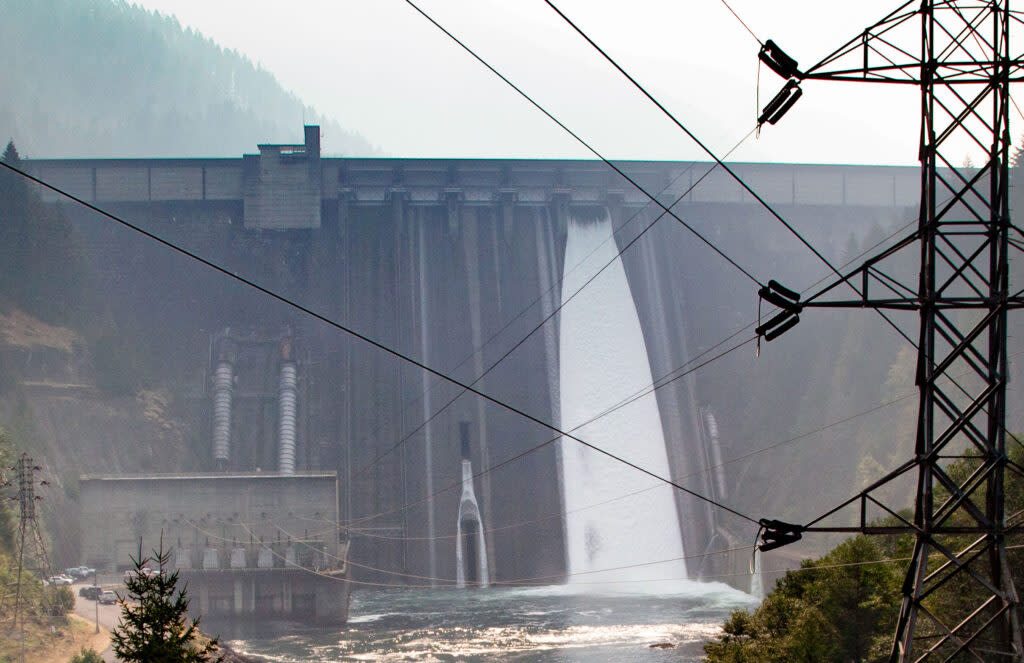Army Corps misses key deadline to report to Congress on ending Willamette hydropower to save salmon

Detroit Dam southeast of Salem on the North Santiam River provides hydropower and flood risk management but also blocks fish passage. (Courtesy of U.S. Army Corps of Engineers)
Inexplicable delays to a federal report on ending hydropower generation in the Willamette River Basin to save threatened fish are creating frustration and concern for tribal leaders and conservationists in Oregon.
Congress directed the U.S. Army Corps of Engineers in 2022 to produce a report by the end of June 2024, detailing the impacts that eight federal hydroelectric dams in the Willamette River Basin have had on native fish populations over the past 60 years, and the possibility of deauthorizing hydropower at the dams to save the fish. Ending hydropower generation at the dams can’t happen without congressional approval.
Instead, the report is sitting in Washington, D.C., under administrative review.
Kerry Solan, a spokesperson for the Portland District of the Army Corps of Engineers, said her office submitted its disposition report – an evaluation of corps projects that no longer serve their intended purpose – to headquarters in D.C. and that she could not comment further on the process. She could not discuss whether the report from the Portland office was submitted on time or where responsibility for the delay should lay.
Meanwhile, advocates for deauthorizing hydropower at the dams and allowing water levels in reservoirs to be drawn down for safe fish passage say native fish species cannot wait. Upper Willamette River Chinook salmon, steelhead and bull trout are all listed as threatened species under the federal Endangered Species Act. A report from the National Marine Fisheries Service published this week found that populations are continuing to decline. By 2040, some runs could be extinct or nearly extinct, according to the report.
“These fish can’t wait any longer for the corps to stop dragging its feet,” said Jennifer Fairbrother, policy director for the Native Fish Society, at a news conference Thursday.
The corps has in the past resisted deauthorizing hydropower at the dams and allowing draw downs because the reservoirs behind the dams are also used for irrigation and recreation. Officials have instead advocated other, high-cost methods for fish salvage, despite calls from electric utilities and industry groups to end hydropower at the dams because they produce little electricity while harming the fish.
At a news conference Thursday, Kathleen George, tribal councilwoman for the Confederated Tribes of Grand Ronde, said almost every stakeholder agrees that the dams should no longer be used for hydropower.
“This is a unique natural resource policy challenge where you have salmon advocates, you have tribal nations, you have the state of Oregon, you have the Bonneville Power Administration and public power advocates all united in seeing the same solution,” George said. “This is a win-win-win situation that you don’t find just about anywhere else in the world of salmon recovery.”
Little power
The eight hydroelectric dams are among 13 dams the corps operates in the basin and part of the larger federal Columbia River Power System overseen by the corps and the Bonneville Power Administration, which is in charge of marketing hydroelectricity in the system. The Columbia River Power System provides 40% of all hydroelectricity in the U.S.
But the eight Willamette Basin dams produce just 4% of the Columbia River System’s power. They were built between 1940 and 1960 primarily for flood control in the Willamette Valley. And ever since, fish have struggled to get past them, except for when the reservoirs are drawn down. With lower water levels, small fish can reach gates in the dam walls to continue downstream. But lowering water levels compromises hydropower and the reservoirs’ other uses for agriculture and recreation.
Instead of ending hydropower and allowing draw downs, the corps has proposed developing giant fish collectors to transport fish around the dams. It would entail sucking young fish up through a floating vacuum, then depositing them in trucks and driving them downstream to be rereleased into the water. It’s been criticized by many as ineffective and overpriced, and making a bad situation worse.
Operating costs for hydropower production from the eight dams outweigh the revenue, according to a recent federal study, and they’re slated to lose nearly $940 million in the next three decades.
The electricity from the dams has become so expensive that the Eugene Water and Electric Board, which buys power from the Columbia River System, said that it’s not worth continuing to operate the Willamette Basin dams for hydropower, but to repurpose them to ensure fish can pass.
“We already know that the Willamette Basin projects are the least efficient hydropower resources in Bonneville Power Administration’s portfolio,” said Aaron Orlowski, a spokesperson for the utility, in an email. “Changing how they operate will have benefits for fish and wildlife, while saving money for publicly owned utilities.”
GET THE MORNING HEADLINES DELIVERED TO YOUR INBOX
The post Army Corps misses key deadline to report to Congress on ending Willamette hydropower to save salmon appeared first on Oregon Capital Chronicle.

